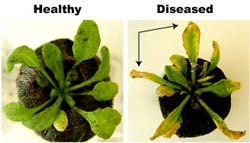Washington, DC
March 10, 2005
In addition to providing physical support and
taking in nutrients, plant roots secrete a wide variety of
compounds that affect other nearby roots, as well as insects and
microbes. But because it goes on unseen, bactericidal root
activity has not been extensively investigated—until now. Using
the model plant
Arabidopsis thaliana, a relative of garden-variety
cabbage, Jorge Vivanco and co-workers at Colorado State
University, together with Frederick Ausubel at Harvard Medical
School, demonstrated that “root exudates” contain antimicrobial
agents that ward off the continual attacks by soil pathogens.
The work is
published in the March 10 issue of the journal
Nature.
|
The
exudates from
Arabidopsis roots kill a wide range of
bacteria, confirming that roots are not always
vulnerable, anchored targets. The natural production of
these antimicrobial chemicals offers one explanation for
why so few bacteria types actually cause disease in
plants. Of the more than 50,000 plant diseases occurring
in the United States, fungal pathogens are the leading
cause.
“Current understanding of plant defenses does not
readily explain why a pathogen can cause disease in one
plant species and not another,” says Vivanco. “Our
findings will help researchers solve the mysteries of
plant disease and immunity.”
In
these experiments, however, root exudates did not kill
all of the tested strains of bacteria. One particular
strain of
Pseudomonas syringae, a bacterium that
causes disease in both tomatoes and
Arabidopsis,
has a seemingly fail-safe mechanism to overcome the
plant’s defenses. The bacterium not only survives
exposure to the antimicrobial substances, it also
blocks the plant's ability to produce them.
Both Vivanco and Ausubel are supported by separate
awards from the division of Molecular and Cellular
Biosciences at
The National Science
Foundation
(NSF). |
 |
|
Plants, including the Arabidopsis thaliana shown
here, secrete antimicrobial compounds from their roots
as part of their defense against potential pathogens.
The plant on the left remains healthy after exposure to
the bacterium Pseudomonas syringae. In contrast, the
plant on the right was exposed to a strain of
Pseudomonas syringae resistant to the antimicrobial
compounds. Arrows highlight the signs of disease.
Credit: Jorge Vivanco,
Colorado State University |
Vivanco is
a recipient of NSF’s prestigious Faculty Early Career
Development Award (CAREER). CAREER awards support the early
career development of those researcher-educators who are deemed
most likely to become the academic leaders of the 21st
century. Parag Chitnis, the NSF program manager of Vivanco’s
award said, “This work is an exciting outcome of a bold and
challenging project. The work paves the way to understand and
combat crop diseases.”
The program
manager for Ausubel’s award, Michael Mishkind said, “The puzzle
of why so few bacterial species are pathogens remains a
fascinating problem. The simple, yet elegant experimental
approaches used by this team uncovered a critical aspect of the
battle that occurs between plants and microbes.”
The National Science Foundation (NSF) is an independent
federal agency that supports fundamental research and education
across all fields of science and engineering, with an annual
budget of nearly $5.47 billion. NSF funds reach all 50 states
through grants to nearly 2,000 universities and institutions.
Each year, NSF receives about 40,000 competitive requests for
funding, and makes about 11,000 new funding awards. The NSF also
awards over $200 million in professional and service contracts
yearly. |